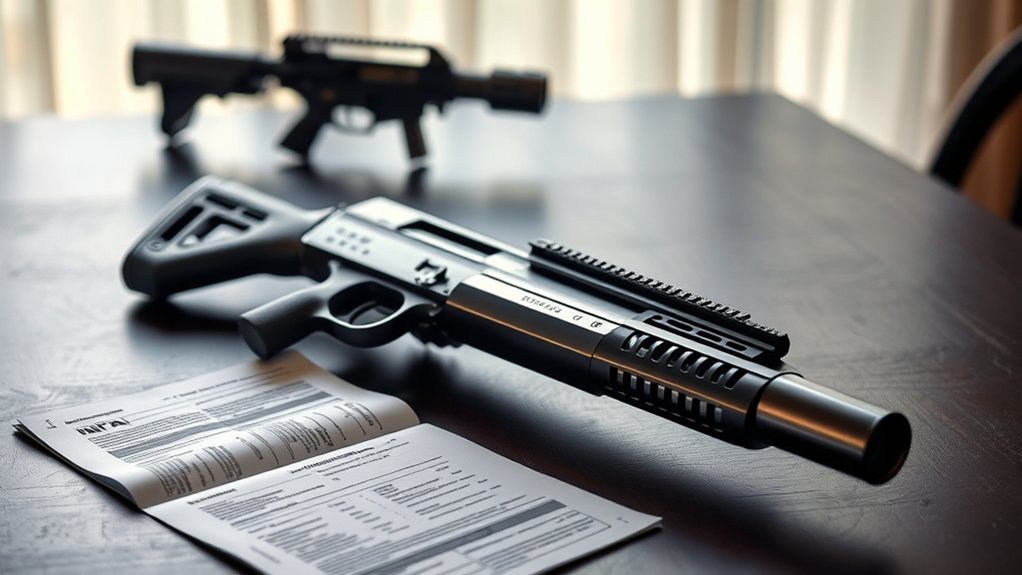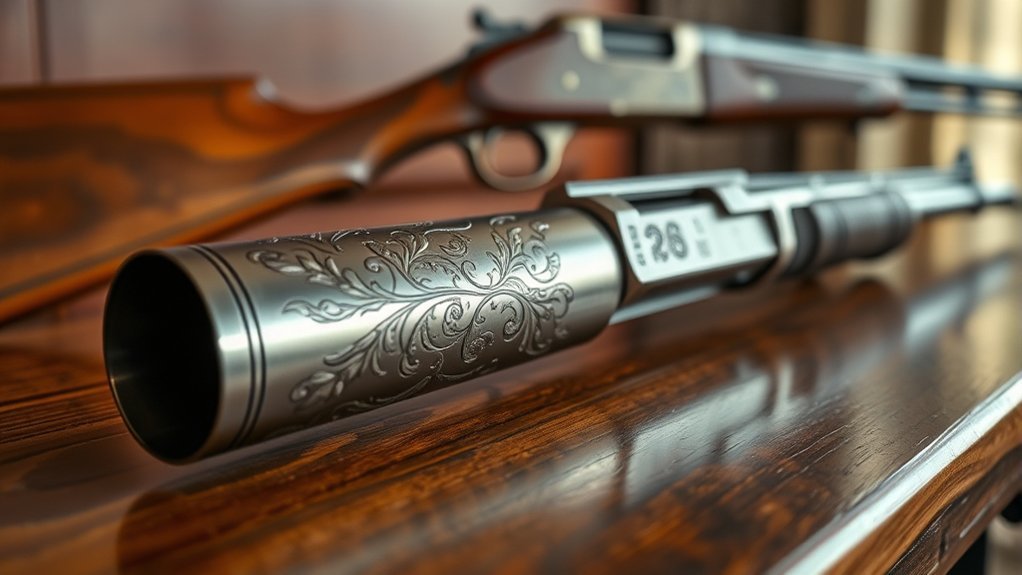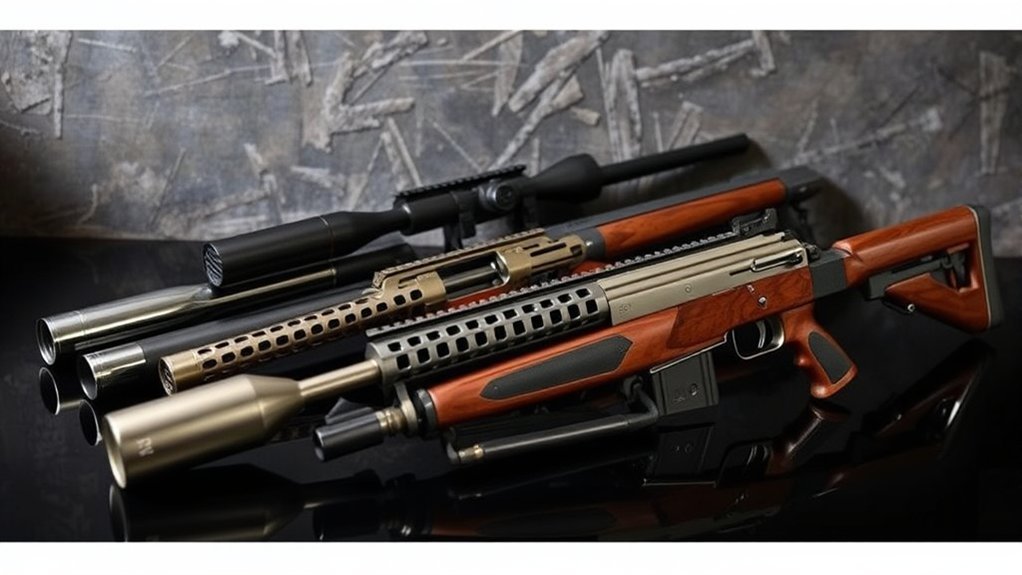When it comes to firearms, understanding the National Firearms Act (NFA) is essential for responsible ownership. NFA items are distinct from standard firearms due to their specific regulations and requirements. These regulations aim to control ownership of particularly dangerous weapons. As you explore this topic, you’ll uncover the categories of NFA items, the acquisition process, and the legal responsibilities that accompany ownership. What implications do these regulations have for gun owners today?
What Is the National Firearms Act (NFA)?

The National Firearms Act (NFA) serves as a significant piece of legislation in regulating specific types of firearms and related items in the United States. Enacted in 1934, it primarily targets items deemed too dangerous for general civilian ownership. You’ll notice that the NFA imposes strict requirements on the sale, transfer, and possession of certain firearms, including machine guns and silencers. It requires individuals to register these items with the Bureau of Alcohol, Tobacco, Firearms and Explosives (ATF) and pay a tax for their transfer or manufacture. This act aims to enhance public safety by limiting access to high-risk firearms while also establishing a framework for lawful ownership. Understanding the NFA is vital for anyone interested in firearms regulation and compliance.
Overview of NFA Items

NFA items are specific weapons and devices regulated under the National Firearms Act, encompassing categories like silencers and short-barreled rifles. Understanding the types of NFA items and the legal considerations surrounding them is essential for compliance and responsible ownership. In this overview, you’ll gain clarity on what qualifies as an NFA item and the implications of owning one.
Definition of NFA Items
Firearms enthusiasts often encounter the term “NFA items,” which refers to specific types of weapons and devices regulated under the National Firearms Act. These items are distinct due to their potential for increased lethality and require special handling. NFA items include machine guns, short-barreled rifles, short-barreled shotguns, silencers, and destructive devices. The regulation aims to enhance public safety by imposing stricter controls on these firearms. When you own an NFA item, you’re subject to extensive background checks, registration, and tax requirements. Additionally, these items often come with legal complexities that demand careful navigation to guarantee compliance. Understanding the definition of NFA items is vital for responsible ownership and adherence to federal regulations within the firearms community.
Types of NFA Items
Understanding the various types of NFA items is essential for anyone engaging with firearms legislation. The National Firearms Act categorizes items into several distinct types. First, you have suppressors, which reduce noise from firearms, making shooting more discreet. Next are short-barreled rifles (SBRs), defined by their barrel length and overall length, offering versatility in a compact design. Then there are short-barreled shotguns (SBSs), similar to SBRs but designed for shotgun shells. Machine guns are another category, capable of firing multiple rounds with a single trigger pull. Finally, you’ll find destructive devices, which include explosive weapons and certain large-caliber firearms. Recognizing these categories helps you navigate the complexities of NFA regulations effectively.
Legal Considerations Explained
While maneuvering the world of NFA items, it’s essential to grasp the legal considerations that accompany their ownership and use. The National Firearms Act imposes strict regulations on items like suppressors, short-barreled rifles, and machine guns. You must complete a thorough application process, including a background check and fingerprinting, before acquiring these items. Additionally, you’ll need to pay a tax stamp for each item, which can be costly. It’s important to understand that violations can lead to severe penalties, including fines and imprisonment. Always keep your NFA items registered and verify they’re stored securely. Familiarizing yourself with state and local laws is equally significant, as they may impose further restrictions on NFA items. Compliance is key to responsible ownership.
Categories of NFA Items

NFA items can be categorized into several distinct types, each governed by specific regulations and requirements. Understanding these categories is essential for compliance and responsible ownership. Here’s a brief overview of the main NFA item types:
| Category | Description |
|---|---|
| Machine Guns | Fully automatic firearms that fire continuously. |
| Short-Barreled Rifles | Rifles with barrels shorter than 16 inches. |
| Short-Barreled Shotguns | Shotguns with barrels less than 18 inches. |
| Suppressors | Devices that reduce noise from firearms. |
| Any Other Weapon (AOW) | Items that don’t fit other categories, like disguised firearms. |
Familiarizing yourself with these categories can help you navigate the complexities of NFA regulations effectively.
The Process of Acquiring NFA Items
Acquiring NFA items involves a series of steps that require careful attention to detail and adherence to federal regulations. Here’s what you need to do:
- Choose Your Item: Decide which NFA item you want, whether it’s a suppressor, short-barreled rifle, or machine gun.
- Complete Form 4: Fill out the ATF Form 4, providing necessary details about yourself and the item.
- Submit Payment and Fingerprints: Pay the tax stamp fee and submit your fingerprints and passport photos to the ATF for a background check.
Each step is essential in ensuring a smooth acquisition process. Be prepared for potential waiting periods, as the approval process can take several months. Following these steps diligently will help you navigate the complexities of acquiring NFA items successfully.
Legal Considerations and Responsibilities
When you decide to own NFA items, it is crucial to understand the legal landscape surrounding their possession and use. Violating NFA regulations can lead to severe penalties, including hefty fines and imprisonment. You must guarantee compliance with federal, state, and local laws, as they can vary greatly.
| Legal Aspect | Responsibility |
|---|---|
| Registration | File ATF Form 1 or Form 4 |
| Taxes | Pay the $200 tax stamp fee |
| Storage | Secure storage as per guidelines |
| Transfers | Notify ATF for any ownership change |
| Usage | Follow local laws on firing ranges |
Understanding these responsibilities will not only protect you legally but also promote responsible ownership of NFA items.
Differences Between NFA Items and Standard Firearms
When comparing NFA items to standard firearms, you’ll notice significant legal classification differences that impact ownership and usage. NFA items are heavily regulated, imposing stricter ownership restrictions that require additional paperwork and approvals. Understanding these distinctions is essential for anyone considering the acquisition of either type of firearm.
Legal Classification Differences
How do NFA items differ from standard firearms regarding legal classification? The primary distinctions lie in their regulatory framework and the requirements for ownership. Here are three key differences:
- Definition: NFA items include suppressors, short-barreled rifles, and machine guns, while standard firearms are typically handguns and long guns that don’t fall under the NFA’s purview.
- Tax Stamp: Purchasing an NFA item requires a $200 tax stamp and a lengthy approval process, unlike standard firearms, which you can buy immediately in most cases.
- Regulatory Oversight: NFA items are subject to stricter regulations by the Bureau of Alcohol, Tobacco, Firearms and Explosives (ATF), whereas standard firearms have less stringent oversight, allowing for quicker transactions.
Ownership Restrictions Explained
Ownership of NFA items comes with significant restrictions that set them apart from standard firearms. First, you must complete a lengthy application process, including submitting fingerprints and photographs to the Bureau of Alcohol, Tobacco, Firearms and Explosives (ATF). Unlike standard firearms, you’ll also pay a tax stamp fee for each item. Additionally, NFA items require a more thorough background check, which can delay approval. You can’t just buy and sell them freely; transfers require ATF approval, and you must notify the ATF of any changes in ownership or location. Moreover, some states impose additional regulations on NFA items, making it essential to understand both federal and local laws before proceeding with ownership.
Common Misconceptions About NFA Items
Although many people are intrigued by NFA items, they often fall prey to common misconceptions that can lead to confusion and misinformation. Understanding the facts can clear up these misunderstandings:
Many are fascinated by NFA items but often misunderstand their legality and ownership requirements.
- All NFA items are illegal: This isn’t true. NFA items like suppressors and short-barreled rifles are legal to own, provided you follow the necessary regulations and paperwork.
- You can’t transport NFA items: While there are restrictions, you can transport them legally across state lines with the proper documentation.
- Ownership requires a Federal Firearms License (FFL): Not for individuals. You can own NFA items without an FFL, as long as you comply with the NFA requirements and pay the tax stamp.
Conclusion
In conclusion, understanding NFA items is essential for responsible gun ownership. You must navigate complex regulations and guarantee compliance to avoid legal pitfalls. For instance, if you’re considering purchasing a suppressor, remember that it requires a tax stamp and approval from the ATF. Failing to follow the proper process could lead to serious legal consequences. By staying informed and adhering to the guidelines, you can enjoy your NFA items while contributing to public safety.

